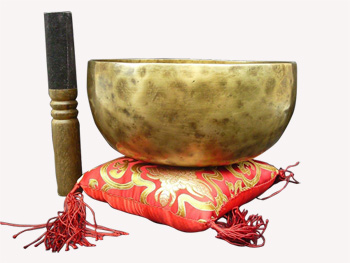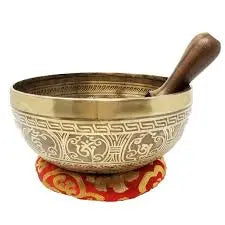Gong vs. Tibetan Singing Bowl: Resonant Differences Unveiled
When it comes to sound therapy, meditation, and spiritual practices, two instruments that stand out are the gong and the Tibetan singing bowl. Each of these resonant instruments has its own unique qualities and history. In this exploration, we'll delve into the world of sound therapy and compare the gong and the Tibetan singing bowl. By the end of this journey, you'll gain insights into their differences, benefits, and which one might be the perfect fit for your needs.

The Gong: A Grand Resonance
Gong Origins and History
Ancient Roots
The gong has deep-rooted origins, with historical records dating back to ancient China. It was initially used in rituals and ceremonies for its powerful and resonant sound.
Sound Characteristics
Gongs are known for their rich, full-bodied sound that can encompass a wide range of frequencies. The vibrations produced by a gong can be both deep and expansive, filling a room with their reverberations.
Gong Therapy
Healing Properties
Gong therapy, also known as gong baths or sound healing with gongs, is gaining popularity for its potential to reduce stress, alleviate pain, and promote relaxation. The powerful vibrations of the gong are believed to have a profound impact on the body and mind.
Varieties of Gongs
There is a wide variety of gongs available, each with its unique size, material, and sound characteristics. These variations allow practitioners to choose a gong that aligns with their intentions and goals.
The Tibetan Singing Bowl: A Gentle Elegance
Singing Bowl Origins and History
Ancient Tradition
Tibetan singing bowls have a rich history in Tibetan and Himalayan cultures. They have been used for centuries in meditation, prayer, and spiritual ceremonies.
Sound Characteristics
Tibetan singing bowls produce a clear, bell-like tone with a soothing and calming quality. The vibrations they create are delicate yet profound, making them ideal for meditation and relaxation.
Singing Bowl Therapy
Therapeutic Benefits
Singing bowl therapy is known for its ability to reduce anxiety, improve focus, and promote emotional well-being. The gentle resonance of singing bowls can create a harmonious atmosphere for healing and self-reflection.
Crafting Singing Bowls
Tibetan singing bowls are traditionally handcrafted using a blend of metals, including copper, tin, and other elements. Each bowl is unique in its design and sound, making them cherished by practitioners and collectors alike.
Choosing the Right Resonance
Consider Your Intention
When choosing between a gong and a Tibetan singing bowl, consider your intention for using sound therapy. If you seek deep, immersive vibrations and a wide frequency range, the gong may be your preference. However, if you value a gentle, soothing resonance for meditation and relaxation, the Tibetan singing bowl might be the better choice.
Personal Sound Preferences
Your personal sound preferences play a significant role in this decision. The gong offers a powerful, grand resonance, while the Tibetan singing bowl provides a more delicate and elegant sound. Listen to both and choose the one that resonates with you.
FAQs
-
Can I use both a gong and a Tibetan singing bowl in my practice?
- Absolutely! Combining the deep resonance of the gong with the gentle tones of the singing bowl can create a balanced and harmonious experience.
-
Are there specific rituals associated with gongs and Tibetan singing bowls?
- Yes, both gongs and Tibetan singing bowls are used in various rituals, ceremonies, and meditation practices worldwide.
-
How can I clean and maintain my gong or Tibetan singing bowl?
- To maintain their sound quality, clean them with a soft, dry cloth and store them in a dry place. Some practitioners also use special mallets or strikers to play them effectively.
-
Do gongs and Tibetan singing bowls have specific chakra-aligning properties?
- Yes, they are often associated with aligning and balancing specific chakras. The choice depends on the instrument's sound characteristics and your intentions.
-
What are some practical tips for incorporating gongs or Tibetan singing bowls into my daily routine?
- You can use them for meditation, relaxation, or as a musical instrument. Experiment with different techniques and find what resonates best with you.
Conclusion
Both gongs and Tibetan singing bowls offer unique and powerful tools for sound therapy, meditation, and spiritual practices. Your choice between the two should align with your intentions, sound preferences, and personal resonance.
Embrace the grand resonance of the gong or the gentle elegance of the Tibetan singing bowl, and allow their harmonious vibrations to guide you on your journey
When it comes to sound healing and meditation, the choice between a Gong vs. Tibetan Singing Bowl can be quite significant. These instruments, although both serving to promote well-being and deep relaxation, achieve their effects through different mechanisms of sound. By understanding their unique properties, you can make a more informed decision on which might be better for your personal practice.
First and foremost, gongs are large, flat, and typically circular percussion instruments that have been used for centuries, mainly in East and Southeast Asian cultures. Made from metals like bronze or brass, gongs produce a deep, resonant tone that can vary in pitch and volume depending on how it is struck. This striking motion generates a powerful vibration, which can create an immersive sound bath that envelops listeners in a wave of auditory sensations. The vibrations of a gong can be very strong and penetrating, making it highly effective for breaking up energy blockages or moving emotions.
On the other hand, Tibetan Singing Bowls are smaller, bowl-shaped instruments originating from the Himalayan region. Typically made of a combination of metals such as copper, tin, and zinc, these bowls produce a harmonious and soothing sound when struck or circled with a mallet. The sound of a Tibetan Singing Bowl tends to be softer and more melodic compared to a gong. This makes singing bowls ideal for meditation, stress reduction, and creating a sense of tranquility. They are often used in personal meditation practices or during yoga sessions to aid in achieving a meditative state.
Another crucial difference between a Gong vs. Tibetan Singing Bowl lies in their sound waves and how they interact with the human body. Gongs create low-frequency sound waves that can physically resonate with the body, potentially aiding in the release of tension in muscles and connective tissues. Meanwhile, the higher frequencies of Tibetan Singing Bowls create a more gentle vibration that can help to quiet the mind and promote a deep sense of calm. This makes singing bowls particularly effective for those who are looking to reduce mental stress or foster a peaceful mind.
In terms of versatility, gongs can cover a wider range of sound frequencies and dynamics, making them suitable for larger group sessions or more intense energy healing practices. However, they require more space and handling expertise. Tibetan Singing Bowls are more portable and easier to use. They are especially favored for individual practices, smaller spaces, and personal energy work.
When deciding between Gong vs. Tibetan Singing Bowl, consider the nature of your practice, the type of sound experience you are seeking, and the specific benefits you hope to gain. Gongs offer a robust and powerful auditory experience that can have profound physical and emotional effects. In contrast, Tibetan Singing Bowls present a more gentle, soothing sound that is excellent for meditation and creating a serene atmosphere. Each instrument has its unique strengths, and understanding these differences can help you choose the one that best aligns with your needs and preferences.

